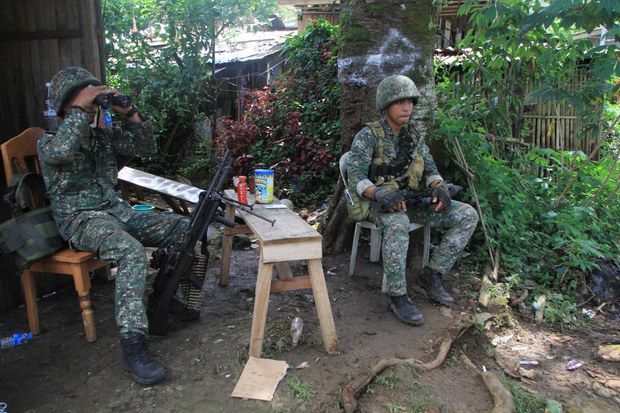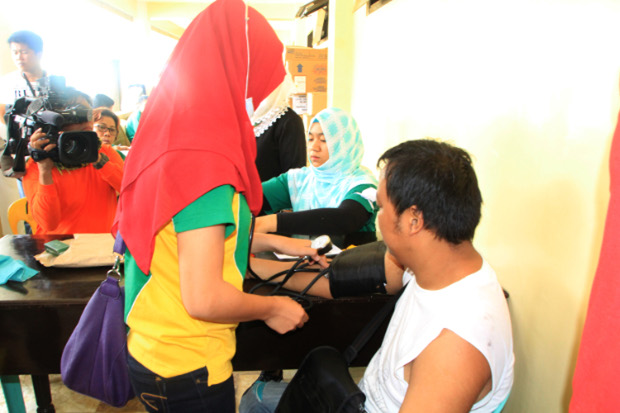Philippine President Offers Bounties for Top IS-Linked Leaders
2017.06.05
Marawi, Philippines
 Philippine troops observe movements of Islamic State-linked fighters during a lull in fighting in the southern city of Marawi, June 4, 2017.
Philippine troops observe movements of Islamic State-linked fighters during a lull in fighting in the southern city of Marawi, June 4, 2017.
Philippine President Rodrigo Duterte on Monday offered large bounties for three militant leaders whose Islamic State-linked fighters have been waging bloody gunbattles with government forces in the southern city of Marawi for nearly two weeks.
Military chief Gen. Eduardo Año said the government had set aside 10 million pesos (U.S. $202, 500) for the capture or killing of Abu Sayyaf Group leader Isnilon Hapilon, the acknowledged leader of Philippine militants who have declared their allegiance to Islamic State (IS).
Duterte also offered 5 million pesos each (U.S. $101, 250) as bounties for brothers Abdullah and Omar Maute, Año said. The brothers lead a small but brutal armed gang that has backed Hapilon’s group in the Marawi area battles since May 23.
“The president is offering 10 million pesos as reward money for the neutralization of Isnilon Hapilon,” Año said.
In addition, the United States has offered a reward of up to $5 million for information leading to the capture of Hapilon, who is on Washington’s list of most-wanted foreign terrorists.
Hapilon, a senior leader of Abu Sayyaf, is believed to be holed up in Marawi. In January this year, he escaped a military strike in his former base in the southern island of Basilan that left him wounded, officials said.
“We hope that this will bear significant accomplishments leading to the eventual arrest and neutralization of Isnilon Hapilon and the Maute brothers,” Año said.
Violence ignited 13 days ago when troops and police moved in to arrest Hapilon, who was spotted in Marawi, a mostly Muslim city of 200,000. But they were surprised to find out he was backed by the Maute group, and fighters from Malaysia, Indonesia, Singapore and Chechnya, among other countries and regions.
The rebels torched buildings and seized a Catholic priest, who later claimed in a video appeal that he was with 240 other hostages. The presence of that number of hostages could not be verified.
MNLF offer
As the government struggled to end the fighting that has killed at least 180 people, according to information from the military, Duterte announced over the weekend that he had accepted an offer from the leader of the Moro National Liberation Front to help repulse any extremists seeking sanctuary in towns under MNLF control in the southern Philippines.
MNLF leader Nur Misuari “has ordered his troops – the able-bodied ones – to fight with government, and I accepted the offer,” Duterte told troops in the southern town of Jolo.
Duterte said he told Misuari he was willing to take in about 2,000 MNLF fighters and integrate them into the armed forces of the government.
MNLF, the largest of Muslim separatist groups in the country, fought a war for secession since the 1970s. In 1996, it signed a landmark peace agreement with the government and saw the creation of an autonomous region in five predominantly Muslim provinces in the southern Philippines.
But in 2003, Misuari launched a rebellion against the government and laid siege to the southern city of Zamboanga. More than 200 people were killed in three weeks of fighting that displaced 100,000 people. The military also suffered heavy casualties.
Misuari, a charismatic, soft-spoken Muslim leader, fled and went into hiding. But since becoming president last year, Duterte has wooed Misuari to come out and promised him he won’t be arrested and charged if he talked again to the government.
“This will only lead to complications in the overall complication for the government effort against the Maute group,” said House of Representatives member Gary Alejano, a former Marine captain. “Combat operations have operational aspects, intelligence and logistics that troops train for.”
“While the intention to help is welcome, bestowing complete trust on them would be problematic,” he said.
Humanitarian efforts stall
Since the fighting erupted on May 23, the once-scenic city of Marawi, about 1,170 km (730 miles) south of the country’s capital Manila, has been transformed into a virtual ghost town. But, humanitarian officials said, hundreds of civilians were still believed to be trapped in the fighting.
Efforts to rescue trapped civilians trapped were stalled Monday, when both sides engaged in heavy fighting despite an earlier negotiated ceasefire to allow remaining residents to evacuate.
Abel Moya, co-convenor of the Saving Lives movement, said the military had been reluctant to allow humanitarian convoys to move in and extricate civilians.
Moya said a humanitarian convoy to rescue residents had yet to leave Iligan City, about 40 km (25 miles) away, by Monday afternoon.
“We are still negotiating with the military. We cannot leave unless they gave us approval,” Moya said.
More than 1,000 people may still be stuck inside Marawi, the International Committee of the Red Cross reported.
Figures on trapped civilians vary from one government agency to another, making it more difficult to account for everyone, said Heidi Anicete, ICRC’s head of communications.
Anicete cited figures from the Autonomous Region in Muslim Mindanao – to which Marawi belongs – saying that some 2,647 individuals were trapped in the city, while the Lanao del Sur provincial government had the figure at more than 1,000.
An estimated 47,116 families, or 235,580 persons, have fled Marawi city since the fighting began, Anicete said.
A humanitarian convoy that entered Marawi on Sunday managed to rescue 100 residents before intense fighting led to the mission being aborted.
“That was a very risky mission. We have a window time of only four hours,” Saff Dipatuan, who headed the convoy, told BenarNews.
Dipatuan said they used megaphones to urge the residents to come out from the buildings.
President Duterte approved the humanitarian convoys as “peace corridors” or pathways to reach the trapped residents.

Abdul Rakman Pundogar, among dozens of civilians rescued by volunteers from besieged Marawi city, gets checked in a clinic at a nearby town in Lanao del Sur province, June 4, 2017. [Richel V. Umel/BenarNews]
Communist guerrillas also offer to help
On Saturday, Duterte said that the communist New People’s Army, which has been engaged in a guerrilla war since the 1960s, had also offered to help the government crush the militants in Marawi.
In 2015, the Philippine Army estimated the strength of the NPA – the armed wing of the Communist Party of the Philippines – at 3,200 fighters deployed in different parts of the country. There are no official figures on how many communist guerrillas operate around Marawi.
“I do not have to train them to go to war. They are at war with us. But if they decide to side with us, then maybe I can solve a little bit of the problem,” Duterte said.
Froilan Gallardo in Iligan City contributed to this story.







